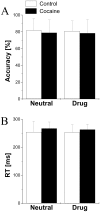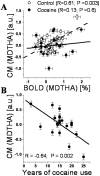Disrupted functional connectivity with dopaminergic midbrain in cocaine abusers
- PMID: 20520835
- PMCID: PMC2876035
- DOI: 10.1371/journal.pone.0010815
Disrupted functional connectivity with dopaminergic midbrain in cocaine abusers
Abstract
Background: Chronic cocaine use is associated with disrupted dopaminergic neurotransmission but how this disruption affects overall brain function (other than reward/motivation) is yet to be fully investigated. Here we test the hypothesis that cocaine addicted subjects will have disrupted functional connectivity between the midbrain (where dopamine neurons are located) and cortical and subcortical brain regions during the performance of a sustained attention task.
Methodology/principal findings: We measured brain activation and functional connectivity with fMRI in 20 cocaine abusers and 20 matched controls. When compared to controls, cocaine abusers had lower positive functional connectivity of midbrain with thalamus, cerebellum, and rostral cingulate, and this was associated with decreased activation in thalamus and cerebellum and enhanced deactivation in rostral cingulate.
Conclusions/significance: These findings suggest that decreased functional connectivity of the midbrain interferes with the activation and deactivation signals associated with sustained attention in cocaine addicts.
Conflict of interest statement
Figures







Similar articles
-
Enhanced midbrain response at 6-month follow-up in cocaine addiction, association with reduced drug-related choice.Addict Biol. 2012 Nov;17(6):1013-25. doi: 10.1111/j.1369-1600.2012.00440.x. Epub 2012 Mar 28. Addict Biol. 2012. PMID: 22458423 Free PMC article.
-
Widespread disruption in brain activation patterns to a working memory task during cocaine abstinence.Brain Res. 2007 Sep 26;1171:83-92. doi: 10.1016/j.brainres.2007.06.102. Epub 2007 Aug 10. Brain Res. 2007. PMID: 17765877 Free PMC article.
-
Dopaminergic involvement during mental fatigue in health and cocaine addiction.Transl Psychiatry. 2012 Oct 23;2(10):e176. doi: 10.1038/tp.2012.110. Transl Psychiatry. 2012. PMID: 23092980 Free PMC article.
-
Thalamo-cortical dysfunction in cocaine abusers: implications in attention and perception.Psychiatry Res. 2007 Aug 15;155(3):189-201. doi: 10.1016/j.pscychresns.2007.03.002. Epub 2007 Jun 19. Psychiatry Res. 2007. PMID: 17582746 Free PMC article.
-
Error-related functional connectivity of the thalamus in cocaine dependence.Neuroimage Clin. 2014 Feb 7;4:585-92. doi: 10.1016/j.nicl.2014.01.015. eCollection 2014. Neuroimage Clin. 2014. PMID: 24936409 Free PMC article.
Cited by
-
MDMA (Ecstasy) association with impaired fMRI BOLD thalamic coherence and functional connectivity.Drug Alcohol Depend. 2012 Jan 1;120(1-3):41-7. doi: 10.1016/j.drugalcdep.2011.06.022. Epub 2011 Jul 31. Drug Alcohol Depend. 2012. PMID: 21807471 Free PMC article.
-
Interactions between the salience and default-mode networks are disrupted in cocaine addiction.J Neurosci. 2015 May 27;35(21):8081-90. doi: 10.1523/JNEUROSCI.3188-14.2015. J Neurosci. 2015. PMID: 26019326 Free PMC article.
-
The transcriptional response to acute cocaine is inverted in male mice with a history of cocaine self-administration and withdrawal throughout the mesocorticolimbic system.Mol Cell Neurosci. 2023 Jun;125:103823. doi: 10.1016/j.mcn.2023.103823. Epub 2023 Mar 1. Mol Cell Neurosci. 2023. PMID: 36868542 Free PMC article.
-
Abstinence to chronic methamphetamine switches connectivity between striatal, hippocampal and sensorimotor regions and increases cerebral blood volume response.Neuroimage. 2018 Jul 1;174:364-379. doi: 10.1016/j.neuroimage.2018.02.059. Epub 2018 Mar 5. Neuroimage. 2018. PMID: 29518566 Free PMC article.
-
Chronic methamphetamine abuse and corticostriatal deficits revealed by neuroimaging.Brain Res. 2015 Dec 2;1628(Pt A):174-85. doi: 10.1016/j.brainres.2014.10.044. Epub 2014 Nov 4. Brain Res. 2015. PMID: 25451127 Free PMC article. Review.
References
-
- Beveridge T, Smith H, Nader M, Porrino L. Effects of chronic cocaine self-administration on norepinephrine transporters in the nonhuman primate brain. Psychopharmacology (Berl) 2005;180:781–788. - PubMed
-
- Volkow N, Fowler J, Wang G, Swanson J, Telang F. Dopamine in drug abuse and addiction: results of imaging studies and treatment implications. Arch Neurol. 2007;64:1575–1579. - PubMed
-
- Borgland S, Taha S, Sarti F, Fields H, Bonci A. Orexin A in the VTA Is Critical for the Induction of Synaptic Plasticity and Behavioral Sensitization to Cocaine. Neuron. 2006;49:589–601. - PubMed
-
- Cunningham K, Paris J, Goeders N. Chronic cocaine enhances serotonin autoregulation and serotonin uptake binding. Synapse. 1992;11:112–123. - PubMed
-
- Volkow N, Wang G, Fowler J, Logan J, Gatley S, et al. Decreased striatal dopaminergic responsiveness in detoxified cocaine-dependent subjects. Nature. 1997;386:830–833. - PubMed
Publication types
MeSH terms
Substances
Grants and funding
LinkOut - more resources
Full Text Sources
Medical

